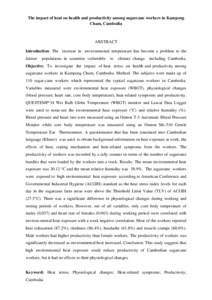Citation
Radir, Ahmad Farhan and Hashim, Zailina and Kongkea, Phan and Vibol, Sao and Hashim, Jamal Hisham
(2018)
The impact of heat on health and productivity among sugarcane workers in Kampong Cham, Cambodia.
Asia Pacific Environmental and Occupational Health Journal, 3 (1).
pp. 9-19.
ISSN 2462-2214
Abstract
Introduction: The increase in environmental temperature has become a problem to the farmer populations in countries
vulnerable to climate change including Cambodia. Objective: To investigate the impact of heat stress on health and productivity among sugarcane workers in Kampong Cham, Cambodia. Method: The subjects were made up of 110 sugar-cane workers which represented the typical sugarcane workers in Cambodia. Variables measured were environmental heat exposure (WBGT), physiological changes (blood pressure, heart rate, core body temperature), heat-related symptoms and productivity. QUESTEMP°34 Wet Bulb Globe Temperature (WBGT) monitor and Lascar Data Logger were used to meas-ure the environmental heat exposure (°C) and relative humidity (%). Blood pressure and heart rate were measured using an Omron T-3 Automatic Blood Pressure Monitor while core body temperature was measured using an Omron Mc-510 Gentle Temperature Ear Thermometer. A questionnaire that has been translated into Cambodian language (Khmer) was used to obtain background information on heat exposure at work, the effects of heat, coping mechanism and heat-related symptoms from the workers. The productivity of workers was recorded by a tally counter in terms of the number of sugarcane bundles that were loaded by the workers into a truck. Results: The mean environmental heat exposure was 30.12 °C and the mean relative humidity was 58.9%. The sugarcane workers were exposed to high environmental heat exposure according to American Conference and Governmental Industrial Hygiene (ACGIH) standard as the heat stress index levels for each day in the sugarcane farm areas were above the Threshold Limit Value (TLV) of ACGIH (27.5°C). There was a significant difference in physiological changes during working and resting periods of workers. However, out of all variables, only core body temperature of males (0.037) and heart rate of females (0.043) during working period were correlated with environ-
mental heat exposure with a weak negative correlation. Most of the workers reported heat exhaustion (87.2%), tiredness
(86.4%), headache (61.8%) and muscle cramps (60.0%). Male workers had higher productivity than female workers. The
productivity of workers was significantly decreased as environmental heat increased. Conclusion: This study suggests that high environmental heat exposure could reduce productivity of Cambodian sugarcane workers, but it had no effects to their physiological changes.
Download File
![[img]](http://psasir.upm.edu.my/63469/1.hassmallThumbnailVersion/The%20impact%20of%20heat%20on%20health%20and%20productivity%20among%20sugarcane%20workers%20.pdf)  Preview |
|
Text (Abstract)
The impact of heat on health and productivity among sugarcane workers .pdf
Download (7kB)
| Preview
|
|
Additional Metadata
Actions (login required)
 |
View Item |

